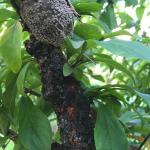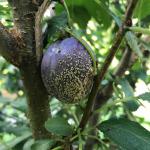UMass Extension's Landscape Message is an educational newsletter intended to inform and guide Massachusetts Green Industry professionals in the management of our collective landscape. Detailed reports from scouts and Extension specialists on growing conditions, pest activity, and cultural practices for the management of woody ornamentals, trees, and turf are regular features. The following issue has been updated to provide timely management information and the latest regional news and environmental data.
To read individual sections of the message, click on the section headings below to expand the content:
Scouting Information by Region
Environmental Data
The following data was collected on or about August 23. Total accumulated growing degree days (GDD) represent the heating units above a 50° F baseline temperature collected via our instruments for the 2017 calendar year. This information is intended for use as a guide for monitoring the developmental stages of pests in your location and planning management strategies accordingly.
|
Region/Location |
GDD |
Soil Temp |
Precipitation |
Time/Date of Readings |
||
|
2-Week Gain |
2017 Total |
Sun |
Shade |
|||
|
Cape Cod |
299 |
1865 |
73 |
69 |
5.63 |
9:00 AM 8/23 |
|
Southeast |
276 |
1682 |
79 |
71 |
0.50 |
5:00 PM 8/23 |
|
North Shore |
294 |
1893 |
68 |
66 |
0.59 |
9:45 AM 8/23 |
|
East |
320 |
2118 |
77 |
73 |
0.27 |
4:00 PM 8/23 |
|
Metro West |
283 |
1920 |
68 |
66 |
0.29 |
6:00 AM 8/23 |
|
Central |
290 |
1932 |
70 |
68 |
0.27 |
8:50 AM 8/23 |
|
Pioneer Valley |
293 |
1980 |
74 |
71 |
1.68 |
10:00 AM 8/23 |
|
Berkshires |
245 |
1661 |
70 |
66 |
1.50 |
9:30 AM 8/23 |
|
AVERAGE |
288 |
1881 |
72 |
69 |
1.34 |
- |
|
n/a = information not available |
||||||
Drought Status: Approximately 86% of Massachusetts is not under official drought status at this time. The 14% classified as 'Abnormally Dry' includes the northernmost portions of Essex county, nearly all of Plymouth county, the southern half of Bristol county, and the entire island of Nantucket. For more information see http://droughtmonitor.unl.edu/Home/StateDroughtMonitor.aspx?MA
Phenology
| Indicator Plants - Stages of Flowering (BEGIN, BEGIN/FULL, FULL, FULL/END, END) | ||||||||
|---|---|---|---|---|---|---|---|---|
| PLANT NAME (Botanic/ Common) | CAPE | S.E. | N.S. | EAST | METRO W. | CENT. | P.V. | BERK. |
| Clematis paniculata (Sweet Autumn Clematis) | * | * | Full | * | * | * | * | * |
| Styphnolobium japonicum (Japanese Pagodatree) | Full | * | End | End | Full | * | Begin | Begin |
| Polygonum cuspidatum (Japanese Knotweed) | Full | Begin/Full | Begin/Full | * | Begin | Begin | Full | Begin |
| Clethra alnifolia (Summersweet Clethra) | Full/End | Full/End | Full/End | Full/End | Full/End | Full/End | Full/End | Full/End |
| * = no activity to report/information not available | ||||||||
Regional Notes
Cape Cod Region (Barnstable)
General Conditions: The average temperature from August 9 - August 23 was 71° F with a high of 84° F on August 19 and a low of 57° F on August 14. Temperatures have generally been in the low 80s or 70s during the day and in the 60s at night with high relative humidity for the majority of the period. 5.63 inches of precipitation fell in Barnstable during the recording period with the majority, just under 5 inches, falling overnight on August 18. During this storm some areas of the Cape received up to 8" inches of rain in as little as 2-3 hours, most areas received 4-5 inches of rain. The heavy rains caused significant flooding and puddling. Topsoil and subsoil moisture is adequate at this time in most locations, some areas with poor drainage have excessive soil moisture.
Pests/Problems: Insect pests or damage seen during the period include Japanese beetle, Asiatic garden beetle, viburnum leaf beetle, two spotted spider mite, chilli thrips, andromeda lacebug, azalea lace bug, leaf hoppers, aphids, hibiscus sawfly, and turpentine beetle. Bald-faced hornets, yellow jackets and mosquitos are active and abundant. Powdery mildew has been observed on lilac, Monarda, rose, Coreopsis, Phlox, white oak, sycamore and dogwood. Tar spot is active on maple. Weeds in bloom include; white clover (Trifolium repens), yellow woodsorrel (Oxalis stricta), purslane (Portulaca oleracea), plantain (Plantago lanceolata), prostrate spurge (Euphorbia maculata), Pennsylvania smartweed (Polygonum pennsylvanicum), Queen Anne's lace (Daucus carota), spotted knapweed (Centaurea maculosa), bittersweet nightshade (Solanum dulcamara), Japanese knotweed (Polygonum cuspidatum), redroot pigweed (Amaranthus retroflexus), and sowthisthle (Sonchus oleraceus), ragweed (Ambrosia artemisiifolia), and porcelain berry (Ampelopsis brevipedunculata). Rabbit populations continue to be a problem.
Southeast Region (Hanson)
General Conditions: While this August has been a bit cooler than previous Augusts with fewer 90 degree days than in past years, there have been some hot days in the 80’s with high humidity and little rain in many areas of Plymouth County. While many other Massachusetts areas have benefited from rainstorms, Hanson has received only 3.75 inches in the past 8 weeks, and only 0.70 inches of rain the past 4 weeks. Unirrigated soils are dry and some trees are dropping leaves, while other trees and plants (rhododendron, hosta, kousa dogwood, etc. are wilting and showing signs of marginal leaf browning. Many oaks that were defoliated this year and in previous years continue to struggle to re-foliate and their canopies are very thin. Remind clients to water high value plants especially those defoliated by caterpillars.
Albizia julibrissin, roses, Rose-of-Sharon, Campsis radicans, Hydrangea paniculata, Hydrangea macrophylla (mostly lacecaps), Hydrangea quercifolia (Oakleaf Hydrangea), Hydrangea arborescens (Smooth Hydrangea), Rubus odoratus, roses, Phlox paniculata (Garden Phlox), Echinacea sp., perennial Hibiscus likeHibiscus 'Summer Storm’, and Hibiscus ‘Old Yella’,Hosta plantaginea and other late blooming Hosta,Persicaria amplexicaulis ‘Firetail’, Joe-pye-weed,Heliopsis ‘Summer Sun’, Helianthus sp., hollyhocks,Liatris spicata, Perovskia atriplicifolia,Ligularia dentata ‘Desdemona’, Goldenrod, Shasta daisy, Nepeta sp., Rudbeckia triloba, Asclepias tuberosa, Rudbeckia fulgida, Rudbeckia ‘Herbstsonne’, Rudbeckia subtomentosa ‘Henry Eilers’, Coreopsis ‘Harvest Moon’ and Campanula sp. are in full bloom. Many ornamental grasses are beginning to bloom, or, are in full bloom.
Clerodendron trichotomum, Lysimachia clethroides , Clethra alnifolia, Echinops ritro (Globe Thistle), Veronicastrum virginicum, and Monarda didyma (Beebalm) are ending bloom.
Monarch and swallowtail butterflies continue to frequent the gardens. Hanson has 3,097 GDD (Growing Degree Days) base 40.
Pests/Problems: Insect pest activity has slowed down, as it usually does in August, but continue to monitor for the following insects which remain active and manage, if found, and needed: Lacebugs, especially on Rhododendron, Pieris and Azalea; dogwood sawfly larvae; Asiatic garden beetles; redheaded pine sawfly larvae; introduced pine sawfly larvae; hibiscus sawfly larvae; spider mites; elongate hemlock scale; lilyleaf beetle larvae. As in past years, Japanese beetles were fewer in number, with not much perceptible damage. Oriental beetles remain active but appear to be about done for the year.
The following insects and pests also remain active: slugs and snails; boxelder beetles; stinkbugs; leafhoppers; ticks; biting flies; sunflower moth caterpillars.
Continue to monitor susceptible trees like maples, horsechestnut, elm, poplar, willow, etc. for signs of Asian Longhorned Beetle (ALB), as peak emergence is usually in August and this insect attacks healthy trees.
Beneficial insects like ladybugs, hoverflies and ambush bugs also remain active.
Unirrigated lawns in many areas are turning brown and it may be due to lack of soil moisture but also consider monitoring those lawns for chinch bugs, grubs, and sod webworm larvae, whose damage may resemble that of drought stress.
Mosquito populations remain high. Continue to take precautions and use a repellent, like DEET, when working outdoors. http://www.mosquitoresults.com/
Continue to watch for wasp and hornet activity while working outdoors; especially while mowing beneath low-hanging branches or when pruning. The grey paper-like nest of the bald-faced hornet is often shaped like a football or basketball and is often well-hidden, hanging within the branches of trees and shrubs.
Tar spot is showing up on Norway maples and is highly visible at this time.
Powdery mildew is beginning to appear on the usual hosts: lilac, dogwood, Beebalm, garden phlox, etc., but not as heavy in past years. Ragweed is in bloom and distributing its’ pollen to which many people may be allergic. Unfortunately, goldenrod often gets blamed.
Deer continue to browse and chipmunks were observed eating all the foliage and stems on ornamental sweet potato vines.
North Shore (Beverly)
General Conditions: The conditions during this reporting period were hot and humid. Day temperatures were mostly in the low to mid 80s during the day and low to mid 60s during the night. Temperatures of 90 degrees and above were recorded only on August 22 during this period. We accumulated a total of 294 growing degree days at Long Hill during this reporting period. Two quick rain storms came through on August 18th and 22nd and brought some rainfall in the area. Approximately 0.59 inches of rainfall were received. Woody plants seen in bloom include: Oakleaf hydrangea (Hydrangea quercifolia), Panicle hydrangea (Hydrangea paniculata), Butterfly bush (Buddleia davidii), Rose-of-Sharon (Hibiscus syriacus), Summer Sweet Clethra (Clethra alnifolia) and Trumpet vine (Campsis radicans). Herbaceous plants seen in bloom include: Culver’s root (Veronicastrum virginicum), False anemone (Anemonopsis macrophylla), Cardinal flower (Lobelia cardinalis), Blue lobelia (Lobelia siphilitica), Garden phlox (Phlox paniculata), hostas (Hosta spp.), sedums (Sedum spp.), Clematis vines (Clematis paniculata), Russian sage (Perovskia atriplicifolia), Feverfew (Tanacetum parthenium), Rudbeckia (Rudbeckia hirta), and Water lily (Nymphaea odorata). Adding even more color in landscapes were an assortment of summer annual plants
Pests/Problems: Powdery mildew was observed on lilac, beebalm (Monarda) and phlox. Tar spot and anthracnose were observed on maples. Weeds continue to thrive in landscapes. Some of the weeds observed in bloom include; white clover (Trifolium repens), yellow woodsorrel (Oxalis stricta), purslane (Portulaca oleracea), prostrate spurge (Euphorbia maculata), bittersweet nightshade (Solanum dulcamara), Japanese knotweed (Polygonum cuspidatum), pigweed (Amaranthus retroflexus), ragweed (Ambrosia artemisiifolia) and goldenrod (Solidago spp. This is a good time to spray Japanese knotweed with glyphosate herbicide. Rabbit populations seem too high this year and are causing problems on some plants. Ticks and mosquitoes continue to be very active. Remember to protect yourself with repellent when working outdoors and in the woods
East Region (Boston)
General Conditions: Over the last two weeks, weather conditions have been typical of New England summers, dry and warm. Daytime highs ranged from 78° F to 91° F, averaging 84° F, while lows have ranged from 55° F to 69° F, averaging 62° F. High humidity and temperatures reaching 91° F, led to oppressive conditions on the 22nd before a cool front moved in bringing low humidity and more fall like conditions. We last hit high temperatures in the 90s on July 21st. Dry conditions prevailed during this recording period; we received minimal rain on three occasions, totaling a mere 0.27 inches, leaving the landscape dry. We have gained 320 GDDs, bringing the total to 2118 GDDs for the year. Trees in bloom include: Albizia julibrissin (silktree), Clethra alnifolia ‘Anne Bidwell’ (Anne Bidwell summersweet clethra), Franklinia alatamaha (Franklin tree), and Koelreuteria paniculata 'September' (September golden rain tree). Colorful fruit is beginning to form on Malus sp. (crabapple), Prunus sp. (cherry), Sambucus sp. (elderberry), Sorbus sp. (mountain ash), and Viburnum sp. (viburnum). We experienced a 63% solar eclipse on the afternoon of August 21st, peaking at 2:46 pm.
Pests/Problems: The lack of precipitation over the last two weeks has left soils dry. Recently established turf has turned brown, going dormant for the season. Supplemental irrigation has begun – the first of the season for established plantings. Dusty conditions are prevalent in sunny areas. Fall color has yet to begin; plants that typically have started turning color by this time of year (Amelanchier sp., Malus sp., and Prunus sp.), remain green and full due to the high levels of precipitation and the moderate temperatures we experienced this summer. Landscape weeds continue to flourish. Weeds in bloom and forming seed include Circaea lutetiana (enchanter's nightshade), Conyza canadensis (Canadian horseweed), Cuscuta spp. (dodder), Cynanchum louiseae (black swallowwort), Echinocystis lobata (wild cucumber), Fallopia convolvulus (wild buckwheat), and Phytolacca americana (pokeweed). Powdery mildew is visible on Syringa sp. (lilac) and Hamamelis sp. (witch hazel).
Metro West (Acton)
General Conditions: There was little rain recorded during this past two-week reporting period, however the total for the month recorded thus far has been 3.99” and the month’s historical monthly average rainfall is 3.72”. Again, we have exceeded the month’s total. However, much of that rain fell fast and furious on August 2nd and now our soils are dry, requiring supplemental irrigation for some plants. Woody plants seen in bloom this past week are: Albizia julibrissin (Silk Tree), Buddleia spp. (Butterfly Bush), Clethra alnifolia (Summersweet), Hibiscus syriacus (Rose-of-Sharon), Hydrangea paniculata (Panicle Hydrangea), and its many cultivars including 'Tardiva', and Potentilla fruiticosa (Potentilla). Contributing even more color and interest to the landscape are some flowering herbaceous plants including: Alcea rosea (Hollyhocks), Asclepias syriaca (Common Milkweed), A. tuberosa (Butterfly Weed), Astilbe spp. (False spirea), Boltonia asteroides (Bolton’s Aster), Cichorium intybus (Chicory), Coreopsis spp. (Tickseed), Daucus carota (Queen Anne's Lace), Echinacea purpurea (Coneflower), Gaillardia aristata (Indian Blanket Flower), H. spp. (Daylily), Hosta spp. (Plantain Lily), Kirengeshoma palmata (Yellow Wax Bells), Lamium maculatum (Dead Nettle), Lavandula angustifolia (Lavender), Leucanthemum sp. (Shasta Daisy), Liatris spicata (Spike Gayfeather), Lilium spp. (Lily), Lysimachia clethroides (Gooseneck Loosestrife), Monarda didyma (Bee-Balm), Patrinia gibbosa (Patrinia), Perovskia atriplicifolia (Russian Sage), Phlox carolina (Carolina Phlox), P. paniculata (Garden Phlox), Platycodon grandiflorus (Balloon Flower), Rudbeckia fulgida var. sullivantii 'Goldsturm' (Black-eyed Susan), Sedum ‘Rosy Glow’ (Stonecrop), Senna marilandica (Wild Senna), Solidago spp. (Goldenrod), and Tradescantia sp. (Spiderwort).
Pests/Problems: Observed in the landscape this past two weeks were leaf blotch on Aesculus sp. (Horsechestnut), powdery mildew on Hamamelis (Witch Hazel), Monarda (Beebalm), Phlox, and Syringa (Lilac), Cedar Apple Rust on Amelanchier sp. (Serviceberry) and the leaf chewer, blister beetle feeding on Clematis recta ‘Purpurea’.
Central Region (Boylston)
General Conditions: Lack of rainfall means that turf is drying out in unirrigated areas and gardens and transplants require supplemental watering. Sweet pepperbush (Clethra alnifolia) is winding down its bloom but still filling the air with its sweet perfume. Adding to the fragrance is harlequin glorybower (Clerodendron trichotomum) and summer phlox (Phlox paniculata). Russian sage (Perovskia atriplicifolia), Anemonopsis macrophylla, Joe-pye-weed (Eupatorium maculatum), Rudbeckia ‘Herbstsonne’, Rudbeckia fulgida var. sullivantii ‘Goldsturm’, Hydrangea paniculata cultivars, Persicaria bisorta ‘Superba’, heathers (Calluna vulgaris cultivars) and many annuals and tender perennials are blooming, vegetables are ripening and the gardens are lush after a mostly very favorable growing season.
Pests/Problems: Pine Sawfly larvae are active and feeding on white pine (Pinus strobus) and Japanese red pine (P. densiflora). We are beginning to see fall webworm along roadsides. Tomato hornworms, hibiscus sawfly and blister beetles continue to appear.
Pioneer Valley Region (Amherst)
General Conditions: August in the Pioneer Valley usually means dense morning fog blanketing the valley bottoms and this year has been no different. It’s been fairly dry and humid for much of Hampshire and Hampden Counties over this past reporting period. Franklin County has fared much better with recent rainfall, significantly skewing the average for the tri-county region. Weather stations in Greenfield recorded rainfall totals ranging from 2.9 – 3.7″ while points southward towards Springfield achieved far less, not even approaching 1″. High temperatures have on average hovered in the middle 80s but with the humidity it has felt much hotter. On Tuesday 8/22 we experienced one of the hottest days of the summer. Ambient air temperatures peaked into the low 90s but very high humidity (dew points in the afternoon reached 74° F), brought the heat index to 100° F. In addition to the heat and humidity, there were high sustained winds with gusts up to 35 mph recorded at Barnes Airport in Westfield. A large band of thunderstorms then swept across the entire northeast, bringing heavy rain and frequent thunder and lightning. Numerous twigs and small branches now litter landscapes with mature trees as a result of the storm. Lawns in shaded settings have fared well this season while those in sunny locations lacking irrigation are partially brown. The recent rainfall from the 8/22 storm and cooler nights forecasted (in middle 50s) should help to disrupt summer dormancy. But overall, the long-term forecast calls for continued dry weather, which will likely break the streak of above-average rainfall this growing season. We are losing approximately two minutes of light per day as August progresses toward September.
Pests/Problems: Numerous landscape trees and shrubs are shedding leaves at this time, especially rosaceous hosts such as serviceberry, hawthorn, crabapple, apple and cherry. A variety of foliar pathogens are mostly responsible for the early leaf shedding, including apple scab and marssonina leaf spot on crabapple and apple, entomosporium leaf spot on hawthorn, and cherry leaf spot on cherry. Black knot and brown rot were observed on plums in a home orchard (see photo in Disease section). The black knot cankers were covered with a dusty white coating, representing spore masses. Exercise caution when pruning black knot when the fungus is sporulating to minimize risk of spread. The brown rot fungus, Monilinia, was also sporulating from infected plums which appear as brown-colored, dusty masses on the surface. Over the next few weeks, the fruit will become “mummified” and hang in the canopy. It’s important to remove infected fruit to reduce inoculum at the site. Marginal leaf scorch is visible on maples and linden. Tar spot on Norway maple is locally abundant but is not nearly as bad here in the Pioneer Valley compared to locations in eastern Mass. Japanese beetle populations have been lower this year compared to previous years but feeding damage is visible on trees like oak, birch and elm. Guignardia leaf blotch of horsechestnut is very conspicuous right now, appearing as marginal leaf browning in many cases. Some trees canopies are entirely brown and the trees have the appearance of the being burned. As bad as sycamore anthracnose was this year on American sycamore and London planetree, many mature sycamores appear robust at this time with full canopies. The brown cubical rot pathogen, Phaeolus schweinitzii, is starting to fruit in the valley. It was observed growing next to Norway spruce and Japanese larch on the UMass campus. When fresh, the overlapping, annual shelves of this root and butt rot pathogen appear dark yellow to brown and often grow from infected roots a few feet away from the main trunk. Damage from serviceberry lacebug is visible and is contributing to premature leaf shedding. A mass of redhumped caterpillars were observed defoliating leaves on a kousa dogwood. Ragweed seems plentiful this season, along with many other landscape weeds. On the flip side, many native flowering perennials like joe pye weed, goldenrod and queen anne’s lace are also having a great year.
Berkshire Region (Great Barrington)
General Conditions:The pattern continued during the past two weeks, i.e. several days of sunny weather followed by a day of rain. It could be considered an ideal pattern for promoting growth of plants. Temperatures for the most part were at normal levels for this time of year. The exception was August 22 when the temperature at this reporting site reached 89° F, the hottest of the summer thus far. Soils remain moist due to the frequency of rainfall. Rarely has irrigation been required for lawns and landscapes. It seems that every year some particular plant stands out in the landscape. Earlier in the year, flowering of lilacs was so pronounced and radiant that it seemed every landscape had one. Currently, it is hydrangeas which stand out. This includes not only Hydrangea paniculata, but also H. arborescens, both of which have had long sustained blooms. Even a few H. macrophylla, a marginally hardy species in the Berkshires, remain in bloom. Growth of turfgrass has been rapid this season and, except for scalped lawns, lawns have shown no signs of browning or summer dormancy. All in all, it has been an outstanding growing season.
Pests/Problems: Insect pressure remains low, but foliar diseases are common on many herbaceous and woody species. Some scab and rust infected crabapples are almost completely defoliated. Many woody and non-woody species have at least some leaf spot disease. Tar spot can be found on Norway maples and silver maples. Powdery mildew is another common ailment and has inflicted the usual hosts, i.e, lilacs, susceptible phlox, and nine bark. Tussock moth caterpillars are the most common leaf muncher at this time of year. The hickory tussock moth was observed on many hickories. Aphids and scale insects are apparent as indicated by sooty mold on Liriodendron tulipifera and Magnolia sp. Asiatic garden beetles are plentiful. Nuisance pests including deer ticks, mosquitoes, wasps, hornets, ants, slugs, and earwigs. Extensive browsing by deer has been occurring, especially on tender herbaceous plants such as hosta. The populations of voles, chipmunks, and rabbits have been very high this year resulting in considerable damage to plants in landscapes and vegetable gardens.
Regional Scouting Credits
- CAPE COD REGION - Russell Norton, Horticulture and Agriculture Educator with Cape Cod Cooperative Extension, reporting from Barnstable.
- SOUTHEAST REGION - Deborah Swanson, UMass Extension Horticulturist for Plymouth County - Retired, reporting from Hanson.
- NORTH SHORE REGION - Geoffrey Njue, Green Industry Specialist, UMass Extension, reporting from the Long Hill Reservation, Beverly.
- EAST REGION - Kit Ganshaw & Sue Pfeiffer, Horticulturists, reporting from the Arnold Arboretum, Jamaica Plain.
- METRO WEST REGION – Julie Coop, Forester, Massachusetts Department of Conservation & Recreation, reporting from Acton.
- CENTRAL REGION - Joann Vieira, Superintendent of Horticulture, reporting from the Tower Hill Botanic Garden, Boylston.
- PIONEER VALLEY REGION - Kelly Allen for Nick Brazee, Plant Pathologist, UMass Extension Plant Diagnostic Lab, reporting from UMass Amherst.
- BERKSHIRE REGION - Ron Kujawski, Horticultural Consultant, reporting from Great Barrington.
Woody Ornamentals
Diseases
Recent pests and pathogens of interest seen in the UMass Extension Plant Diagnostic Lab:
Browning and premature shedding of foliage on Norway maple (Acer platanoides) caused by tar spot (Rhytisma americanum) and maple anthracnose (Discula sp.). Symptoms have been steadily intensifying in recent weeks and some trees are shedding large volumes of foliage. Tar spot is gaining much of the attention, due to the striking and conspicuous signs of the pathogen. Maple anthracnose, however, may deserve more of the blame as it has been abundant on a variety of maples all season, including those with tar spot. In areas where Norway maple was heavily planted, especially shaded settings, the damage is severe but not likely fatal. A comment from a homeowner with a badly infected, mature Norway maple: “My partner is always complaining about the number of leaves he has to rake from our trees in the fall. Well, now he can start early.”
Stem cankering of balsam fir (Abies balsamea) caused by Cytospora. Symptoms appeared as scattered canopy dieback, focused mostly in the lower canopy. Needles are reddening and prematurely shedding from shoot tips, progressively spreading inward on affected branches. The tree is approximately eight to ten-years-old and resides in a sunny ornamental bed on a wooded edge with other conifers. Oak and pine are present on the property and without supplemental irrigation, the site may be too dry to support healthy growth of balsam fir.
Browning needles and shoot tip dieback of Swiss stone pine (Pinus cembra) caused by Botryosphaeria. Tree is 11-years-old and was planted in early spring of this year in an ornamental bed with other conifers and hardwoods. The setting is shaded and supplemental water was not provided to the tree after transplanting. Approximately two months ago, needles began to brown and shoot tips died throughout the canopy, but the damage was particularly bad in the lower to middle canopy. Botryosphaeria is more often found as a stem cankering pathogen but has the ability to attack conifer needles, as was the case here. Numerous black-colored pads of fungal tissue (pycnidia) were present at the base of the needles.
Dieback of Norway spruce (Picea abies) caused by a severe infestation of the Norway spruce gall midge (Piceacecis abietiperda), infestation of the spruce spider mite (Oligonychus ununguis) and stem cankering caused by Phomopsis. Two trees at a residential property, one is less than 15-years-old and was transplanted only two years ago while the other is roughly 85-years-old. The younger tree is badly disfigured, with a dead terminal and blighted shoot tips throughout the lower canopy. In the older tree, the damage is more severe on interior branches and while many branches are still alive, premature needle shedding and stem dieback is significant. Stem distortion is the best symptom of an infestation from afar with the galls (and adult midge exit holes) clustered at the base of dead shoots requiring closer examination.
Needle and shoot blight of Green Giant arborvitae (Thuja plicata × standishii ′Green Giant′) caused by Pestalotiopsis. Trees are 6′ tall and were planted five weeks ago in a residential setting. Symptoms appeared two weeks after planting as browning needles and shoot dieback in the lower canopy. The trees were installed to surround a new basketball court made of hard plastic tiles. Interestingly, the lower canopy symptoms are more pronounced on the side facing the basketball court, suggesting some influence of the tiles. Drip irrigation is provided to the trees and soils are loamy with good drainage. Pestalotiopsis is common and destructive on arborvitae, especially trees suffering from winter injury and transplant shock.
Cherry leaf spot of sweet cherry (Prunus avium) caused by Blumeriella jaapii. One of several Prunus samples submitted to the lab recently harboring this fungal pathogen. Tree is approximately 20-years-old and resides in a home fruit orchard surrounded by open lawn with half sun. Leaves have black spots, are yellowing and prematurely shedding from the canopy. The fungus produces an abundance of very small, white-colored spore masses on the underside of infected leaves that may be visible upon inspection. Abundant early season moisture set the stage for greater disease severity this year.
Report by Nick Brazee, Plant Pathologist, UMass Extension Plant Diagnostic Lab, UMass Amherst.
Insects
Photo-worthy insects and (non-insect) damage seen this scouting period, because not all insects we see in our landscapes are pests:
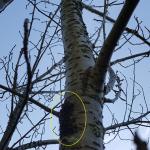
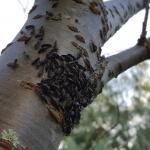
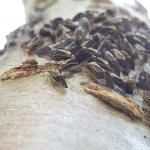 Barklice: order Psocoptera is comprised of the “booklice” and “barklice”. A common family of the Psocoptera that is found in the Northeast are the Psocidae. Certain species within that family, such as Cerastipsocus venosus are relatively large in size and gregarious – meaning that they hang out in tightly packed groups of many individuals, sometimes referred to as “herds”. These types of barklice can be found in ornamental landscapes. It is this herding behavior that will quickly draw the eye to patches or groups of these insects. The particular herd in the photo was observed on a standing dead tree in a residential landscape. While approaching the herd from far away, it looks perhaps like a raised fungal pad of sorts – until you get close enough to see hundreds of individuals, long antennae extending into the air. The Psocidae, or common barklice, including species such as C. venosus graze in these groups on lichen, fungi, or other organic matter. Although the word “lice” is bound to elicit a reaction of disgust in most, these beautiful little insects with their conspicuously marked bodies and delicate wings held almost rooflike over their backs are not pests. These insects are harmless, although they certainly have a look of suspicion about them, the way they all gather – particularly when found at the “scene of the crime”, if you will, such as in this example. So next time you are asked about a herd of barklice lurking about, know that they are not pests and do not require management.
Barklice: order Psocoptera is comprised of the “booklice” and “barklice”. A common family of the Psocoptera that is found in the Northeast are the Psocidae. Certain species within that family, such as Cerastipsocus venosus are relatively large in size and gregarious – meaning that they hang out in tightly packed groups of many individuals, sometimes referred to as “herds”. These types of barklice can be found in ornamental landscapes. It is this herding behavior that will quickly draw the eye to patches or groups of these insects. The particular herd in the photo was observed on a standing dead tree in a residential landscape. While approaching the herd from far away, it looks perhaps like a raised fungal pad of sorts – until you get close enough to see hundreds of individuals, long antennae extending into the air. The Psocidae, or common barklice, including species such as C. venosus graze in these groups on lichen, fungi, or other organic matter. Although the word “lice” is bound to elicit a reaction of disgust in most, these beautiful little insects with their conspicuously marked bodies and delicate wings held almost rooflike over their backs are not pests. These insects are harmless, although they certainly have a look of suspicion about them, the way they all gather – particularly when found at the “scene of the crime”, if you will, such as in this example. So next time you are asked about a herd of barklice lurking about, know that they are not pests and do not require management.
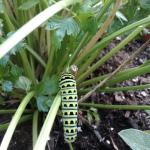
 Eastern Black Swallowtail Caterpillar: the immature or caterpillar stage of Papilio polyxenes or the eastern black swallowtail may also be commonly referred to as a parsleyworm. This is because caterpillars of this species often feed on cultivated carrots, dill, and parsley. This insect is one of the most common and most studied swallowtails in North America. It is found in southern Canada, the eastern and mid-western USA, further west to the Rocky Mountains, and into northern Mexico. Parsleyworms undergo striking color changes as the caterpillar grows and develops over time. Because this insect shares the same palate for certain cultivated items such as herbs found in our gardens, there are some who may view these gorgeous caterpillars as pests. They have tachinid fly and hymenopteran (wasp) parasitoids as natural enemies. The adult butterfly is one of our largest and arguably one of our most attractive insects. When at all possible, resist the urge to kill or remove parsleyworms. These caterpillars are typically not in large enough numbers to truly cause a problem. If you do grab a mature parsleyworm caterpillar, be prepared for the osmeterium. This is a brightly colored, often orange-yellow organ that the larva will protrude from its first abdominal segment in a defensive display. The osmeterium is often coated in a smelly chemical deterrent that the insect attempts to coat the assailant with in self-defense.
Eastern Black Swallowtail Caterpillar: the immature or caterpillar stage of Papilio polyxenes or the eastern black swallowtail may also be commonly referred to as a parsleyworm. This is because caterpillars of this species often feed on cultivated carrots, dill, and parsley. This insect is one of the most common and most studied swallowtails in North America. It is found in southern Canada, the eastern and mid-western USA, further west to the Rocky Mountains, and into northern Mexico. Parsleyworms undergo striking color changes as the caterpillar grows and develops over time. Because this insect shares the same palate for certain cultivated items such as herbs found in our gardens, there are some who may view these gorgeous caterpillars as pests. They have tachinid fly and hymenopteran (wasp) parasitoids as natural enemies. The adult butterfly is one of our largest and arguably one of our most attractive insects. When at all possible, resist the urge to kill or remove parsleyworms. These caterpillars are typically not in large enough numbers to truly cause a problem. If you do grab a mature parsleyworm caterpillar, be prepared for the osmeterium. This is a brightly colored, often orange-yellow organ that the larva will protrude from its first abdominal segment in a defensive display. The osmeterium is often coated in a smelly chemical deterrent that the insect attempts to coat the assailant with in self-defense.
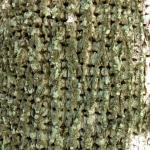
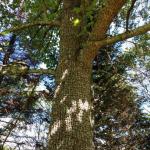
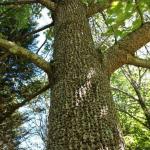 Sapsucker Damage: Not every hole found in a tree is from an insect. The yellow-bellied sapsucker (Sphyrapicus varius) is a medium-sized woodpecker found throughout the northeast and much of the United States and Canada. This bird will create shallow holes sometimes referred to as sap wells in the bark of trees in order to feed on the sap that flows into them. In this particular photo example, this tulip tree (Liriodendron tulipifera) had nearly every inch of the trunk and larger branches covered with sap wells.
Sapsucker Damage: Not every hole found in a tree is from an insect. The yellow-bellied sapsucker (Sphyrapicus varius) is a medium-sized woodpecker found throughout the northeast and much of the United States and Canada. This bird will create shallow holes sometimes referred to as sap wells in the bark of trees in order to feed on the sap that flows into them. In this particular photo example, this tulip tree (Liriodendron tulipifera) had nearly every inch of the trunk and larger branches covered with sap wells.
Woody ornamental insect and non-insect arthropod pests to consider, a selected few:
- Asian Longhorned Beetle, Anoplophora glabripennis, ALB: Look for signs of an ALB infestation which include perfectly round exit holes (about the size of a dime), shallow oval or round scars in the bark where a female has chewed an egg site, or sawdust-like frass (excrement) on the ground nearby host trees or caught in between branches. Be advised that other, native insects may create perfectly round exit holes or sawdust-like frass, which can be confused with signs of ALB activity. Adults of this insect are (historically) active at this time in the regulated area in Massachusetts.
The regulated area for Asian longhorned beetle is 110 miles2 encompassing Worcester, Shrewsbury, Boylston, West Boylston, and parts of Holden and Auburn. If you believe you have seen damage caused by this insect, such as exit holes or egg sites, on susceptible host trees like maple, or have captured an adult beetle that you believe to be ALB, please call the Asian Longhorned Beetle Eradication Program office in Worcester, MA at 508-852-8090 or toll free at 1-866-702-9938.
To report an Asian longhorned beetle find online or compare it to common insect look-alikes, visit: http://massnrc.org/pests/albreport.aspx or https://www.aphis.usda.gov/pests-diseases/alb/report.
- Asiatic Garden Beetle: Maladera castanea adults are active and are typically most abundant in July and August. These rusty-red colored beetles are bullet-shaped and active at night. They are often attracted to porch lights. They feed on a number of ornamental plants, defoliating leaves by giving the edges a ragged appearance and also feeding on blossoms. Butterfly bush, rose, dahlia, aster, and chrysanthemum can be favored hosts. When levels of damage reach a management threshold, pyrethroid- based insecticides may be necessary. Read and follow label instructions and avoid harming non-target organisms. Certain neem oil products are also labelled for use against adult beetles. Observe label instructions to minimize the potential for leaf injury.
- Black Vine Weevil: Otiorhynchus sulcatus damage is apparent on rhododendron and taxus, but can also be seen on azalea, mountain laurel, and Euonymus. Adult weevils feed along the leaf/needle margins and create rounded notches. Inspect foliage of these plants for notching from last season’s feeding. Adults emerged in June and create new damage to leaves for this season. All individuals are females and reproduce asexually. This insect has developed resistance to many chemical insecticides. Entomopathogenic nematodes such as Steinernema carpocapsae, S. feltiae, and Heterorhabditis bacterio-phora work well against this insect, particularly on containerized plants. Results in the landscape vary. Wetting the soil thoroughly prior to application and keeping it wet for at least 5 days following application can help increase the efficacy of the nematodes. Burlap laid around the base of plants during the time adults are active, through August, can be inspected weekly for adult weevils which can be killed before egg laying.
- Elongate Hemlock Scale: Fiorinia externa is found on eastern, Carolina, and Japanese hemlock, as well as yew, spruce, and fir. Crawlers will be present throughout the growing season and the overlap of many developmental stages at any given time can be observed.
- Emerald Ash Borer (EAB): A new county detection of Agrilus planipennis (EAB) was made using green panel traps and a combination of a host plant volatile chemical and pheromone (sexual attractant) lures placed in Brookline, MA. This is unfortunately a new county detection (Norfolk County) in Massachusetts for 2017. (However, it is in very close proximity to a prior detection made in Suffolk County.) EAB has previously been detected in Berkshire County (2012), Essex County (2013), Suffolk County (2014), Worcester County (2015), and Hampden County (2016). In this case, two green panel traps, hung in close proximity to one another, captured 6 adult beetles between them, which were collected on 7/14/17 and sent to the UMass Plant Diagnostics Laboratory for confirmation. This identification was also confirmed by the USDA Animal and Plant Health Inspection Service (APHIS).
EAB readily attacks ash (Fraxinus spp.) including white, green, and black ash and has also been found developing in white fringe tree (Chionanthus virginicus) and most recently, cultivated olive (Olea europaea). (See: https://academic.oup.com/jee/article-lookup/doi/10.1093/jee/tox139 .) Adult insects of this species are active. Signs of an EAB infested tree may include D-shaped exit holes in the bark, “blonding” or lighter coloration of the ash bark from woodpecker feeding (chipping away of the bark as they search for larvae beneath), and serpentine galleries visible through splits in/upon peeling the bark, from larval feeding beneath. Positive identification of an EAB-infested tree may not be possible with these signs individually on their own.
For a map of the known locations of emerald ash borer in the state, as well as further information about this insect, please visit: https://ag.umass.edu/fact-sheets/emerald-ash-borer. If you believe you have located EAB-infested ash trees, particularly in an area of Massachusetts not identified on the map provided, please report it at the Massachusetts Introduced Pests Outreach Project: http://massnrc.org/pests/pestreports.htm.
- Fall Home-Invading Insects: Various insects, such as ladybugs, boxelder bugs, seedbugs, and stink bugs will begin to seek overwintering shelters in warm places, such as homes, throughout the next couple of months. While such invaders do not cause any measurable structural damage, they can become a nuisance especially when they are present in large numbers. While the invasion has not yet begun, if you are not willing to share your home with such insects, now should be the time to repair torn window screens, repair gaps around windows and doors, and sure up any other gaps through which they might enter the home.
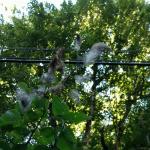
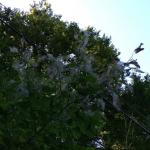 Fall Webworm: Hyphantria cunea is native to North America and Mexico. It is now considered a world-wide pest, as it has spread throughout much of Europe and Asia. (For example, it was introduced accidentally into Hungary from North America in the 1940’s.) Hosts include nearly all shade, fruit, and ornamental trees except conifers. In the USA, at least 88 species of trees are hosts for these insects, while in Europe at least 230 species are impacted. In the past history of this pest, it was once thought that the fall webworm was actually two species. It is now thought that H. cunea has two color morphs – one black headed and one red headed. These two color forms differ not only in the coloration of the caterpillars and the adults, but also in their behaviors. Caterpillars may go through at least 11 molts, each stage occurring within a silken web they produce over the host. When alarmed, all caterpillars in the group will move in unison in jerking motions that may be a mechanism for self-defense. Depending upon the location and climate, 1-4 generations of fall webworm can occur per year. Fall webworm adult moths lay eggs on the underside of the leaves of host plants in the spring. These eggs hatch in late June or July depending on climate. Young larvae feed together in groups on the undersides of leaves, first skeletonizing the leaf and then enveloping other leaves and eventually entire branches within their webs. Webs are typically found on the terminal ends of branches. All caterpillar activity occurs within this tent, which becomes filled with leaf fragments, cast skins, and frass. Fully grown larvae then wander from the webs and pupate in protected areas such as the leaf litter where they will remain for the winter. Adult fall webworm moths emerge the following spring/early summer to start the cycle over again. 50+ species of parasites and 36+ species of predators are known to attack fall webworm in North America. Fall webworms typically do not cause extensive damage to their hosts. Nests may be an aesthetic issue for some. If in reach, small fall webworm webs may be pruned out of trees and shrubs and destroyed. Do not set fire to H. cunea webs when they are still attached to the host plant.
Fall Webworm: Hyphantria cunea is native to North America and Mexico. It is now considered a world-wide pest, as it has spread throughout much of Europe and Asia. (For example, it was introduced accidentally into Hungary from North America in the 1940’s.) Hosts include nearly all shade, fruit, and ornamental trees except conifers. In the USA, at least 88 species of trees are hosts for these insects, while in Europe at least 230 species are impacted. In the past history of this pest, it was once thought that the fall webworm was actually two species. It is now thought that H. cunea has two color morphs – one black headed and one red headed. These two color forms differ not only in the coloration of the caterpillars and the adults, but also in their behaviors. Caterpillars may go through at least 11 molts, each stage occurring within a silken web they produce over the host. When alarmed, all caterpillars in the group will move in unison in jerking motions that may be a mechanism for self-defense. Depending upon the location and climate, 1-4 generations of fall webworm can occur per year. Fall webworm adult moths lay eggs on the underside of the leaves of host plants in the spring. These eggs hatch in late June or July depending on climate. Young larvae feed together in groups on the undersides of leaves, first skeletonizing the leaf and then enveloping other leaves and eventually entire branches within their webs. Webs are typically found on the terminal ends of branches. All caterpillar activity occurs within this tent, which becomes filled with leaf fragments, cast skins, and frass. Fully grown larvae then wander from the webs and pupate in protected areas such as the leaf litter where they will remain for the winter. Adult fall webworm moths emerge the following spring/early summer to start the cycle over again. 50+ species of parasites and 36+ species of predators are known to attack fall webworm in North America. Fall webworms typically do not cause extensive damage to their hosts. Nests may be an aesthetic issue for some. If in reach, small fall webworm webs may be pruned out of trees and shrubs and destroyed. Do not set fire to H. cunea webs when they are still attached to the host plant.- Gypsy Moth: Lymantia dispar adult activity is at an end for the 2017 season. The Massachusetts Department of Conservation and Recreation (DCR) has released preliminary numbers for the total acres defoliated by gypsy moth caterpillars in 2017. MA DCR officials estimate that approximately 922,460 acres were defoliated by gypsy moth in 2017. This is just over 2.6 times more defoliation than what was seen from this insect in the state in 2016, when approximately 350,000 acres of defoliation were estimated to have occurred due to gypsy moth. A preliminary map of this defoliation for 2017 can be viewed here. Given these numbers, we are certainly very lucky (in most locations) that the gypsy moth caterpillar-killing fungus known as Entomophaga maimaiga “kicked in” when it did.
Management at this time is typically not effective. The young, feeding caterpillars that will hatch from egg masses (currently stuck to trees, lawn furniture, and other inanimate objects) next spring are the life stage to be targeted for management.
For more information about gypsy moth and its management next season: http://ag.umass.edu/landscape/fact-sheets/gypsy-moth and for an overview of the 2017 season and gypsy moth activity, please visit: http://ag.umass.edu/landscape/news/gypsy-moth-caterpillars-dying-across-massachusetts.
- Hickory Tussock Moth: Lophocampa caryae is native to southern Canada and the northeastern United States. There is one generation per year. Overwintering occurs as a pupa inside a fuzzy, oval shaped cocoon. Adult moths emerge approximately in May and their presence can continue into July. Females will lay clusters of 100+ eggs together on the underside of leaves. Females of this species can fly, however they have been called weak fliers due to their large size. When first hatched from their eggs, the young caterpillars will feed gregariously in a group, eventually dispersing and heading out on their own to forage. Caterpillar maturity can take up to three months and color changes occur during this time. These caterpillars are essentially white with some black markings and a black head capsule. They are very hairy, and should not be handled with bare hands as many can have skin irritations or rashes (dermitis) as a result of interacting with hickory tussock moth hairs. By late September, the caterpillars will create their oval, fuzzy cocoons hidden in the leaf litter where they will again overwinter. Hosts whose leaves are fed upon by these caterpillars include but are not limited to hickory, walnut, butternut, linden, apple, basswood, birch, elm, black locust, and aspen. Maple and oak have also been reportedly fed upon by this insect. Several wasp species are parasitoids of hickory tussock moth caterpillars.
- Japanese Beetles: Popillia japonica adult beetles were first reported as active in Massachusetts the week of June 23rd this year and continue to be spotted across the landscape. Adult female beetles will lay their eggs primarily by early August, however eggs may be laid into September. Females lay these eggs in groups in soil cavities they excavate 2-4 inches down. Japanese beetles overwinter as nearly grown grubs in the soil which are capable of evading freezing behaviorally by moving below the frost line. As soils warm in the spring, larvae become active and feed on the roots of grasses. Pupation occurs 1-3 feet below the soil surface. Adults emerge from these lawn areas and disperse to feed on foliage, mate, and return to turf-type locations for females to lay their eggs. Japanese beetle adults use aggregation pheromones (chemicals that signal between individuals) to call in others of the same species. These pheromones and volatile chemicals from host plants being fed upon are thought to be the reason why large numbers of these beetles can be found feeding together. Adult beetles feed on foliage and flowers, often skeletonizing leaves until they appear lace-like. Larvae are highly damaging turf pests. Tree and shrub hosts are comprised of more than 300 species including but not limited to rose, mountain-ash, willow, linden, elm, Japanese and Norway maples, birch, sycamore, rose of Sharon, ornamental apple, and many others. Adult beetles are often attracted to feeding on sunny areas of the plant. Many organisms are parasitoids of Japanese beetles, such as two wasps that attack overwintered grubs in the spring, and a tachinid fly (winsome fly: Isocheta aldrichi) which parasitizes newly emerged adult beetles. Other organisms act as generalist predators with Japanese beetles on their menus, including but not limited to ants, certain other beetles, small mammals, and birds.
- Lace Bugs: Stephanitis spp. lacebugs such as S. pyriodes can cause severe injury to azalea foliage. S. rhododendri can be common on rhododendron and mountain laurel. S. takeyai has been found developing on Japanese andromeda, leucothoe, styrax, and willow. Stephanitis spp. lace bugs should be monitored through September. Before populations become too large, treat with a summer rate horticultural oil spray as needed. Be sure to target the undersides of the foliage in order to get proper coverage of the insects. Fall or early spring soil treatment with imidacloprid has been effective, but be aware of the implications this may have on pollinators attracted to these flowering plants when making management decisions. Certain azalea and andromeda cultivars may be less preferred by lace bugs.
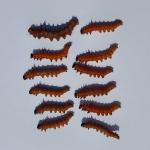 Redhumped Caterpillar: Schizura concinna caterpillars develop into a type of prominent moth (Family: Notodontidae) and are sometimes defoliators of ornamental trees and shrubs. Host plants of S. concinna include apple and crabapple, but many woody plant hosts have been reported, comprising of but not limited to: pear, cherry, plum, sweetgum, walnut, redbud, and willow. The caterpillars in this particular photo were caught feeding on kousa dogwood in Massachusetts. The caterpillars of this species are commonly encountered and widespread throughout North America. One generation is produced per year in northern locations, although multiple generations per year have been reported in warmer areas of this species’ range. Eggs can be laid in groups of 25-100 on the undersides of leaves. The caterpillars of the species are spectacular in their color and ornamentation. They have red or black head capsules, are yellow in color with white longitudinal stripes bordered in red down the sides of the body, and possess black projections (tubercles) on each body segment. The fourth body segment counting from the head capsule (not counting the head but just behind it) has a red, pronounced hump with prominent black tubercles that are larger (and longer) than the others present on the body. At rest, these caterpillars may have their rear-end elevated. Caterpillars will feed in groups when first hatched from their egg, often skeletonizing the underside of leaves initially. As the caterpillars grow in size, they are capable of consuming entire leaves. They often feed on the same limb/branch together in a group, stripping everything except leaf veins. These larvae are typically more problematic on smaller trees, whereas larger trees may not be extensively impacted. Caterpillars mature by August or September and drop to the ground. Pupae are shiny and reddish-brown in color and may be enclosed within a silken cocoon and are found in the soil. Adult moths are comparatively drab and dull when considered next to the caterpillars of this species; moths are light gray to brown in color with some white markings. Many parasitic wasps and tachinid fly species have been reported as natural enemies of this caterpillar. Predatory insects have also been reported. When these caterpillars are small and because of their tendency to be present in groups, mechanical management is possible by either pruning out the branch they are feeding on or removing them with a gloved hand.
Redhumped Caterpillar: Schizura concinna caterpillars develop into a type of prominent moth (Family: Notodontidae) and are sometimes defoliators of ornamental trees and shrubs. Host plants of S. concinna include apple and crabapple, but many woody plant hosts have been reported, comprising of but not limited to: pear, cherry, plum, sweetgum, walnut, redbud, and willow. The caterpillars in this particular photo were caught feeding on kousa dogwood in Massachusetts. The caterpillars of this species are commonly encountered and widespread throughout North America. One generation is produced per year in northern locations, although multiple generations per year have been reported in warmer areas of this species’ range. Eggs can be laid in groups of 25-100 on the undersides of leaves. The caterpillars of the species are spectacular in their color and ornamentation. They have red or black head capsules, are yellow in color with white longitudinal stripes bordered in red down the sides of the body, and possess black projections (tubercles) on each body segment. The fourth body segment counting from the head capsule (not counting the head but just behind it) has a red, pronounced hump with prominent black tubercles that are larger (and longer) than the others present on the body. At rest, these caterpillars may have their rear-end elevated. Caterpillars will feed in groups when first hatched from their egg, often skeletonizing the underside of leaves initially. As the caterpillars grow in size, they are capable of consuming entire leaves. They often feed on the same limb/branch together in a group, stripping everything except leaf veins. These larvae are typically more problematic on smaller trees, whereas larger trees may not be extensively impacted. Caterpillars mature by August or September and drop to the ground. Pupae are shiny and reddish-brown in color and may be enclosed within a silken cocoon and are found in the soil. Adult moths are comparatively drab and dull when considered next to the caterpillars of this species; moths are light gray to brown in color with some white markings. Many parasitic wasps and tachinid fly species have been reported as natural enemies of this caterpillar. Predatory insects have also been reported. When these caterpillars are small and because of their tendency to be present in groups, mechanical management is possible by either pruning out the branch they are feeding on or removing them with a gloved hand. - Viburnum Leaf Beetle: Pyrrhalta viburni is a beetle in the family Chrysomelidae that is native to Europe, but was found in Massachusetts in 2004. Adult beetles are expected to be active roughly through October, or when the first frost hits. Adult beetles will create their own feeding damage, but will also mate and females will lay eggs in the stems of the viburnums, typically beginning in late-June to mid-July until October. This beetle feeds exclusively on many different species of viburnum including but not limited to susceptible plants such as V. dentatum, V. nudum, V. opulus, V. propinquum, and V. rafinesquianum. Some viburnum have been observed to have varying levels of resistance to this insect, including but not limited to V. bodnantense, V. carlesii, V. davidii, V. plicatum, V. rhytidophyllum, V. setigerum, and V. sieboldii. More information about viburnum leaf beetle may be found at http://www.hort.cornell.edu/vlb/.
- Chilli Thrips: The non-native, exotic chilli thrips (Scirtothrips dorsalis) has been confirmed from two samples of damaged Hydrangea spp. foliage from two residential landscapes located in Barnstable County, MA submitted to the UMass Plant Diagnostics Laboratory. At this time, this pest has not been confirmed in nurseries or greenhouses in Massachusetts or on any other host plants. Due to the limited number of samples, the significance of chilli thrips in Massachusetts is not yet known. This species of thrips is a significant global pest of economically important ornamental, vegetable, and fruit crops in southern and eastern Asia, Oceania, and parts of Africa. It was first determined to be established in the United States in 2005 in Florida, although previous interceptions of this pest were detected. It is reportedly a pest of over 100 host plants belonging to over 40 plant families, including, but not limited to, pepper, strawberry, blueberry, cotton, rose, peanut, Japanese privet, Rhododendron spp., Viburnum spp., eggplant, grapes, melon, tobacco, and tomato. For more information, please visit this Chilli Thrips Fact Sheet (https://ag.umass.edu/landscape/fact-sheets/chilli-thrips) available on the UMass Extension Landscape, Nursery, and Urban Forestry Program web page.
Concerned that you may have found an invasive insect or suspicious damage caused by one? Need to report a pest sighting? If so, please visit the Massachusetts Introduced Pests Outreach Project: http://massnrc.org/pests/pestreports.htm.
Pollinator Protection Resource Online: The Massachusetts Department of Agricultural Resources has developed a Massachusetts Pollinator Protection Plan. It is a set of voluntary guidelines that discuss best management practices for stakeholders seeking to promote the health of the European honeybee and other pollinators. This document includes information for beekeepers, pesticide applicators, land managers and farmers, nurseries and landscapers, and homeowners and gardeners. Please locate the MA Pollinator Protection Plan for more information here: http://www.mass.gov/eea/docs/agr/farmproducts/apiary/pollinator-plan.pdf.
A note about Tick Awareness: deer ticks (Ixodes scapularis), the American dog tick (Dermacentor variabilis), and the lone star tick (Amblyomma americanum) are all found throughout Massachusetts. Each can carry their own complement of diseases. Anyone working in tick habitats (wood-line areas, forested areas, and landscaped areas with ground cover) should check themselves regularly for ticks while practicing preventative measures. Have a tick and need it tested? Visit the web page of the UMass Laboratory of Medical Zoology (https://www.tickreport.com/) and click on the red Test a Tick button for more information.
- For information about protecting yourself from ticks and tick-borne diseases, please visit: https://ag.umass.edu/landscape/fact-sheets/information-regarding-ticks-tick-borne-diseases.
- For information about managing ticks in landscapes, among other topics, please visit the following publication from the Connecticut Agricultural Experiment Station: “Tick Management Handbook”: http://www.ct.gov/caes/lib/caes/documents/publications/bulletins/b1010.pdf.
Weeds
Treating the biennial weed garlic mustard, Alliaria petiolata, from now through fall will control first-year plants that would flower and produce seed next spring.
Japanese knotweed is in flower and now is the time to manage this invasive plant. Use a 2% spray solution of glyphosate sprayed to the initiation of spray drip. Do not use herbicide formulations that contain diquat (RewardTM) or tank-mix pelargonic acid (ScytheTM) with the glyphosate. Diquat and pelagonic acid are contact herbicides and have the potential to decrease the efficacy of glyphosate. Non-chemical products containing clove oil, citric acid, acetic acid or orange extract will not effectively control Japanese knotweed. In areas near water, a formulation of glyphosate that is labelled for these areas should be used. Often Japanese knotweed is found in areas near water. These areas may be within Massachusetts Wetlands Protection Act jurisdiction and will require you to work with the Conservation Commission in the municipality to obtain approval and permits for the management of Japanese knotweed.
Perennial weeds in landscape beds should be treated now. Use a non-selective translocated herbicide such as glyphosate. Contact herbicide such as diquat, pelagonic acid and non-chemical products that contain clove oil, citric acid, acetic acid or orange extract should not be used.
Fall is an excellent time to control tough, creeping perennials such as Canada thistle, mugwort, quackgrass, bindweed and horsenettle. Many times these weeds arrive on a site as a result of introduced B&B nursery stock, so these areas should be examined first. Treat with a non-selective, translocated (systemic) herbicide (eg. glyphosate). Contact (ScytheTM, RewardTM) or the non-chemical/organic herbicide products will provide “burndown” activity only and will not adequately control these weeds.
Summer annual weeds are headed toward the end of their life cycle and this means seed production, so any strategy that can be implemented now to remove plants before seeds fall will be helpful in the long run.
Report by Randall Prostak, Weed Specialist, UMass Extension Agriculture and Commercial Horticulture Program
Management Practices
Plant of the Week: Calamagrostis x acutiflora ‘Karl Foerster’, Karl Foerster feather reed grass

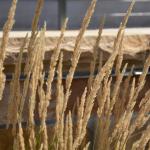 Calamagrostis x acutiflora ‘Karl Foerster’ is a narrow, upright ornamental grass growing around 5’ tall and 2’ wide. The bright green leaves reach around 3’ tall with feathery flower plumes rising above the foliage to around 5’. Pink-tinged flower plumes in the summer are followed by golden brown seeds that mature to light brown. Calamagrostis x acutiflora ‘Karl Foerster’ is a hybrid that results from a cross between Calamagrostis arundinacea and C. epigejos. The cultivar is named for Karl Foerster, who discovered the plant in the Hamburg Botanical Garden and later introduced it into commerce. Calamagrostis x acutiflora ‘Karl Foerster’ has no serious insect or disease problems. It is a great choice for narrow spaces. Karl Foerster feather reed grass grows well in medium to wet soils in full sun, making it a good choice for rain gardens. Foliage can be floppy if planted in too much shade. Clumps should be cut back in late winter before new spring growth appears.
Calamagrostis x acutiflora ‘Karl Foerster’ is a narrow, upright ornamental grass growing around 5’ tall and 2’ wide. The bright green leaves reach around 3’ tall with feathery flower plumes rising above the foliage to around 5’. Pink-tinged flower plumes in the summer are followed by golden brown seeds that mature to light brown. Calamagrostis x acutiflora ‘Karl Foerster’ is a hybrid that results from a cross between Calamagrostis arundinacea and C. epigejos. The cultivar is named for Karl Foerster, who discovered the plant in the Hamburg Botanical Garden and later introduced it into commerce. Calamagrostis x acutiflora ‘Karl Foerster’ has no serious insect or disease problems. It is a great choice for narrow spaces. Karl Foerster feather reed grass grows well in medium to wet soils in full sun, making it a good choice for rain gardens. Foliage can be floppy if planted in too much shade. Clumps should be cut back in late winter before new spring growth appears.
Report by Mandy Bayer, Extension Assistant Professor of Sustainable Landscape Horticulture, UMass Stockbridge School of Agriculture
Landscape Turf
Insects
Over the past several days, I have observed several things on my own lawn that might be of interest to some of you.
Turfgrass ants - Ant mounding has become apparent in some of the drier areas of my lawn. While ants seldom cause damage at lawn heights of cut, they can be quite a nuisance on fairways or greens of area golf courses. (The ants push up mounds that can be abrasive to mowing equipment, can dull the blades, and can suffocate the turf underneath them.) Often overlooked, however, is that ants are usually good predators of other insects, including the eggs and small larvae of white grubs and caterpillars.
If a golf course superintendent believes that treatment is necessary, there is a short term approach and a long term approach. The short term approach involves applying a pyrethroid or chlorpyrifos (the latter is only registered for use on golf courses). These products will kill many of the ants that are on the surface, foraging or defending the colony, and this will reduce the evidence of mound building. However, the chemicals will not reach the queen, so she will continue to produce prodigious numbers of eggs and the colony will persist. To truly impact the colony, the superintendent must use an ant bait registered for use on turf against ants. The baits are much slower, so you will not see an immediate knockdown in mounding activity, but the effect will be much longer lasting once the queen is killed. If you use a bait, do not apply before rain, and do not irrigate for at least 24 hours after application.
Sod webworms - I have noticed large numbers of sod webworm moths flying around my lawn over the past couple weeks. While there do not seem to be quite as many as I saw last year, they are quite noticeable. (The moths are rather tubular in shape, as they fold their wings tightly around their bodies, and they tend to fly haphazardly just above the canopy, often in late afternoon or evening.) I did not notice any damage from the caterpillars that hatched last summer. Indeed I do not usually receive complaints about sod webworm feeding activity in New England.
Nevertheless, sod webworms (there are many species, at least some of which have two generations per year with adults laying eggs in late summer) are capable of damaging turf. In this case the caterpillars feed through late summer into mid fall, and then spin a little silken "hibernaculum", like a silk blanket, that protects them from desiccation, and hibernate through the winter. During that hibernation, they replace most of the water in the tissues between the cells with a liquid that acts like anti-freeze, preventing cell damage when the insect encounters freezing conditions. They emerge in mid spring and resume feeding for a few weeks before pupating and emerging as adults in late spring or early summer. So if you see new caterpillar damage in the spring in New England, it probably is caused by one of the species of sod webworms that overwinters as caterpillars.
Sod webworms appear to be perfectly happy feeding on home lawn-maintained turf, as well as athletic fields, golf courses, parks, and cemeteries. So if you believe you might have had some damage last fall, or you are noticing an unusually large number of moths flying this year, you can apply a pyrethroid sometime in the next week or two. The pyrethroid will stay in the thatch and kill the caterpillars as they hatch out of the eggs.
White grubs - While poking around in my lawn last week, I found several white grubs (a mixed bag of species), all of which appeared to be right on target developmentally. In other words, they were young third instars, and clearly they were feeding quite actively. The timing of egg-laying and development seems to have followed the "normal" pattern this year, in part because we have received timely rain throughout the summer in the Connecticut River valley.
If you applied chlorantraniliprole between mid April and early June, you should be in very good shape. And if you applied a neonicotinoid during the ideal timing (when the adults were laying eggs) in early summer, you should also achieve very good levels of control. The exception for both approaches is if you have very thick or dense thatch. Either condition can make it difficult to achieve good contact of the insecticide with the grubs.
Finally, now would be an excellent time to scout for white grub activity. As mentioned, the grubs are getting quite large but because we have had consistent rain events, the turf is still growing quite well and masking grub activity. But as the grubs get larger (and if we experience a period of a week or more without rain), grub feeding damage will become apparent. The best curative approach for white grubs is trichlorfon, but it cannot be used on school grounds in Massachusetts (and several other states in the Northeast). This restriction is at least in part because it is a very soluble chemical so it is more likely to leach or run-off than most other grub insecticides.
Report by Dr. Pat Vittum, Professor Emerita and Extension Turf Entomologist, UMass Amherst Stockbridge School of Agriculture.
Additional Resources
To receive immediate notification when the next Landscape Message update is posted, be sure to join our e-mail list and follow us on Facebook and Twitter.
For a complete listing of upcoming events, see our Upcoming Educational Events page.
For commercial growers of greenhouse crops and flowers - Check out the New England Greenhouse Update website
For professional turf managers - Check out Turf Management Updates
For home gardeners and garden retailers - Check out home lawn and garden resources. UMass Extension also has a Twitter feed that provides timely, daily gardening tips, sunrise and sunset times to home gardeners, see https://twitter.com/UMassGardenClip
Diagnostic Services
A UMass Laboratory Diagnoses Landscape and Turf Problems - The UMass Extension Plant Diagnostic Lab is available to serve commercial landscape contractors, turf managers, arborists, nurseries and other green industry professionals. It provides woody plant and turf disease analysis, woody plant and turf insect identification, turfgrass identification, weed identification, and offers a report of pest management strategies that are research based, economically sound and environmentally appropriate for the situation. Accurate diagnosis for a turf or landscape problem can often eliminate or reduce the need for pesticide use. For sampling procedures, detailed submission instructions and a list of fees, see Plant Diagnostics Laboratory
Soil and Plant Nutrient Testing - The University of Massachusetts Soil and Plant Nutrient Testing Laboratory is located on the campus of The University of Massachusetts at Amherst. Testing services are available to all. The function of the Soil and Plant Nutrient Testing Laboratory is to provide test results and recommendations that lead to the wise and economical use of soils and soil amendments. For complete information, visit the UMass Soil and Plant Nutrient Testing Laboratory web site. Alternatively, call the lab at (413) 545-2311.
Ticks are active at this time! Remember to take appropriate precautions when working and playing outdoors, and conduct daily tick checks. UMass tests ticks for the presence of Lyme disease and other disease pathogens. Learn more
